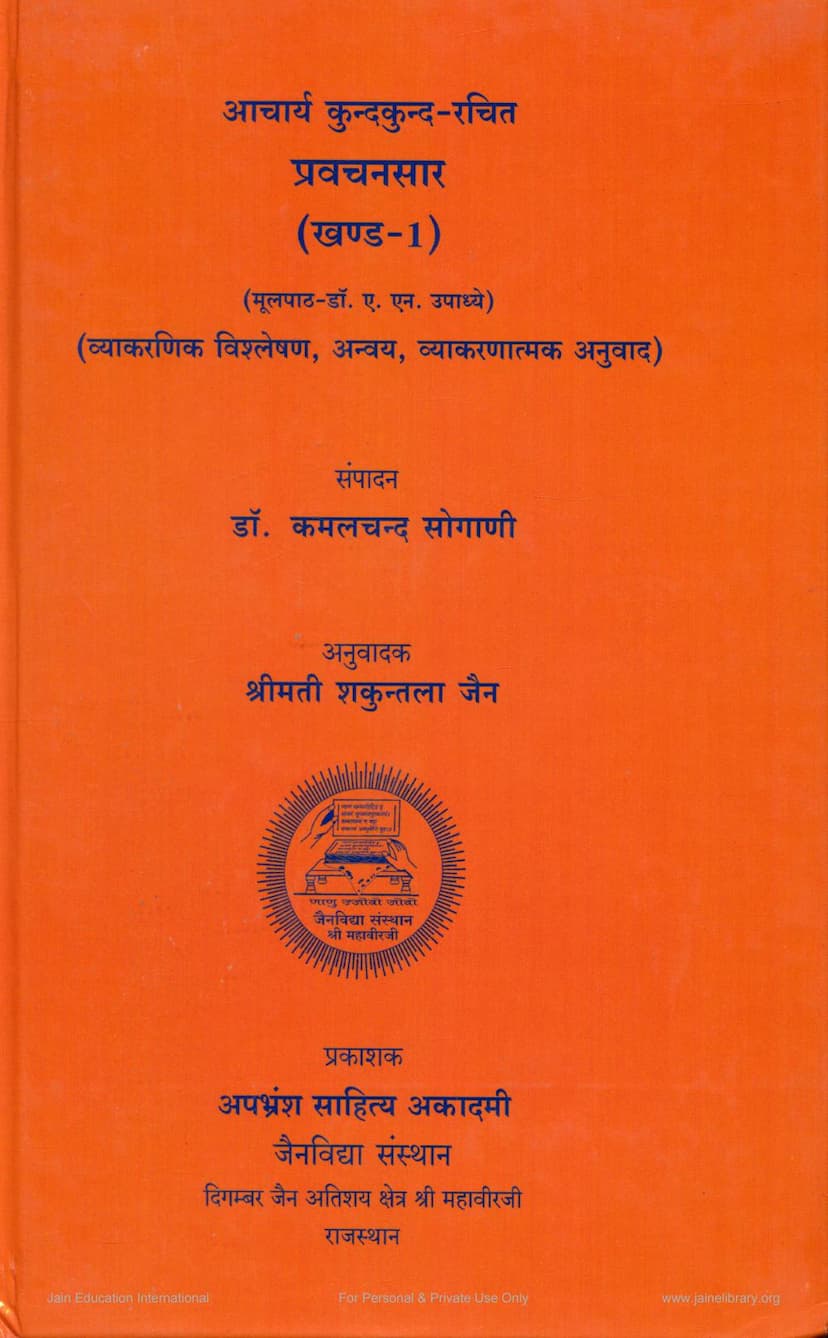Pravachansara Part 01
Added to library: September 2, 2025

Summary
This is a comprehensive summary of the provided text, which is the first volume of the Jain text "Pravachanasara" by Acharya Kundakunda, translated into Hindi by Smt. Shakuntala Jain and edited by Dr. Kamalchand Sogani.
Book Title: Pravachanasara Part 01 Author(s): Acharya Kundakunda (Original), Dr. Kamalchand Sogani (Editor), Smt. Shakuntala Jain (Translator) Publisher: Apbhramsa Sahitya Academy, Jain Vidya Sansthan, Shri Mahavirji, Rajasthan. Catalog Link: https://jainqq.org/explore/004158/1
Overall Purpose:
The book is the Hindi translation of the "Jnana Adhikara" (Knowledge Chapter) of Acharya Kundakunda's seminal work, "Pravachanasara." The goal is to make this profound Jain philosophical text accessible to Hindi-speaking readers, particularly those interested in understanding Jain Dharma and its core doctrines. The edition aims to provide a deep and analytical understanding by including grammatical analysis, word-for-word meaning, and a comprehensive index of grammatical terms.
Key Contents and Themes:
-
Author and Work: The book introduces Acharya Kundakunda, a revered Jain philosopher believed to have lived in the first century CE, known for works like Samaysara, Pravachanasara, Panchastikaya, etc. "Pravachanasara" itself is a significant work in Sauraseni Prakrit, explaining Jain philosophy. It is divided into three chapters: Jnana Adhikara (Knowledge), Jneya Adhikara (Knowable), and Charitra Adhikara (Conduct). This volume focuses exclusively on the Jnana Adhikara, which comprises 92 verses (Gathas).
-
Jnana Adhikara (Knowledge Chapter): This chapter delves into profound spiritual concepts. Its key themes include:
- The Nature of the Soul and Pure Consciousness (Shuddhopyoga): It describes the soul's true nature as pure consciousness, beyond sensory experiences and worldly attachments.
- Kevalajnana (Omniscience): The text explains the state of omniscience, where the soul perceives all realities directly and without any limitations. It highlights the all-pervading nature of this knowledge and how the soul, in this state, is not transformed or affected by the objects of knowledge.
- The Difference Between Sensory and Supra-Sensory Happiness: It contrasts the temporary and conditional happiness derived from senses with the eternal and unconditioned bliss of the soul.
- The Role of Karma: The text explains how karma, particularly the destructive (ghatiya) karma, binds the soul and leads to suffering. The removal of karma leads to liberation.
- The Relationship Between Soul and Matter: It touches upon the interaction between the soul and matter, and how true happiness comes from realizing the soul's inherent nature, not from external objects.
- The Concept of Substance, Attributes, and Modes (Dravya, Guna, Paryaya): While primarily covered in the Jneya Adhikara, the foundations are laid here, emphasizing the reality of substance and its ever-changing modes.
- The Importance of Right Knowledge, Faith, and Conduct (Samyak Darshana, Jnana, Charitra): The verses underscore that true liberation is achieved through the combined practice of these three principles, with pure consciousness (Shuddhopyoga) being the ultimate goal.
- The Difference Between Auspicious (Shubha) and Inauspicious (Ashubha) Activities: The text explains how auspicious actions lead to worldly pleasures (like heavenly existence), while inauspicious actions result in suffering. However, both are considered impure compared to pure consciousness.
- The Soul as the Source of Knowledge and Bliss: The core message is that the soul itself is the knower and the experiencer of bliss, independent of any external factors.
-
Grammatical Analysis and Translation:
- Original Text (Mul Path): The Sauraseni Prakrit verses are presented.
- Grammatical Analysis (Vyakaranik Vishleshan): Each word in the verse is broken down, identifying its grammatical category (noun, verb, adjective, etc.), gender, number, case, tense, and mood. Special symbols are used to denote these categories.
- Anvaya (Word Order): The rearranged word order of the verse for better comprehension in Hindi.
- Vyakaranatmak Anuvad (Grammatical Translation): A word-by-word translation that explains the meaning of each term in Hindi, maintaining its grammatical function.
-
Appendices:
- Glossaries (Sangya-Kosh, Kriya-Kosh, Krudanta-Kosh, Visheshana-Kosh, Sarvanama-Kosh, Avyaya-Kosh): These provide detailed meanings and grammatical information for nouns, verbs, participles, adjectives, pronouns, and indeclinables found in the text, significantly aiding in understanding the Prakrit language.
- Chhanda (Meter): Analysis of the meter used in the verses, primarily the Gaha (Gatha) meter, with its specific syllable counts.
- Testimonials (Sammati): Appreciative remarks from scholars like Dr. Premsuman Jain and Prof. Phoolchand Jain Premi, highlighting the book's scholarly value, its meticulous editing, and its importance for students of Prakrit and Jain philosophy.
Unique Features of this Edition:
The "Pravachanasara Part 01" stands out due to its:
- Detailed Grammatical Breakdown: This makes the study of Prakrit grammar and Jain philosophy exceptionally accessible.
- Clear and Accurate Translation: Smt. Shakuntala Jain's translation is praised for its simplicity and clarity.
- Comprehensive Dictionaries: The extensive glossaries are invaluable for researchers and students.
- ** Scholarly Editing:** Dr. Kamalchand Sogani's editing ensures the accuracy and authenticity of the text.
- Focus on Understanding: The emphasis is not just on providing the text but on facilitating a deep understanding of its philosophical nuances.
In essence, this volume of "Pravachanasara" is a scholarly and accessible rendering of a foundational Jain text, providing readers with a thorough understanding of key spiritual concepts through detailed grammatical analysis and translation.